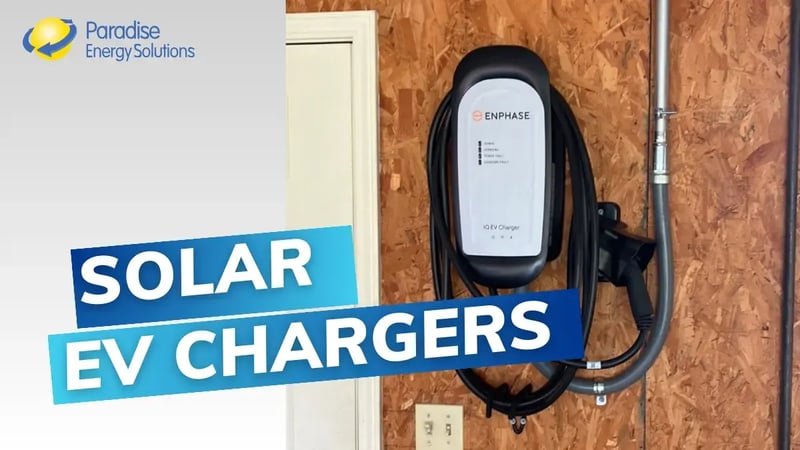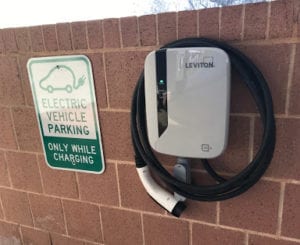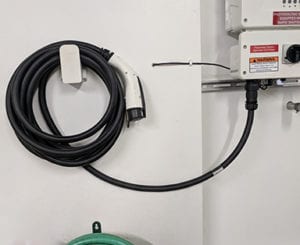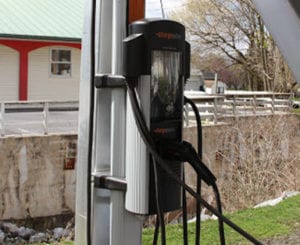Solar EV Chargers: Power Your Car with Sunshine

13,476 miles. That’s how much the average American drives each year, according to the US Department of Transportation. To put that in perspective, you can drive from Anchorage, AK to Miami, FL and back in 9,916 miles.
At a national average of 24.7 mpg, our vehicles will each suck up about 546 gallons of gas this year - which costs around $1,650. We’ll also each contribute 4.6 metric tons of CO2 to Earth’s atmosphere.
Whether it’s to cut expenses, do your part for the environment, or a little of both, more and more Americans are making the switch to hybrid or electric cars. But these next-generation vehicles still need fuel, and electricity isn’t free - unless you have solar power.
Find out what options you have for electric vehicle (EV) charging stations, how much they’ll cost you, and how many panels you’ll need to power your car.
The Types and Costs of EV Car Chargers
There are three types of EV chargers, and which type you decide to install will dictate the cost. Currently, Paradise Energy offers options for private chargers, integrated private chargers, and public chargers.
Private EV Charger
 A private EV charging station will allow you to plug in your electric vehicle and charge up your car’s battery. These can be hooked up to a solar panel system or it can be grid-tied, so if you have an electric car but no solar panels, it’s a great home charging station option.
A private EV charging station will allow you to plug in your electric vehicle and charge up your car’s battery. These can be hooked up to a solar panel system or it can be grid-tied, so if you have an electric car but no solar panels, it’s a great home charging station option.
Costs for a charging station like this will be in the neighborhood of $2,000 - $3,000, if installed in conjunction with a solar array. The cost will depend on several factors, including how far it is installed from your main distribution panel, and whether or not trenching will be required.
Integrated Private EV Charger
 An integrated private charger is similar, but can only be installed with a solar system that has a solar inverter that’s the right brand and size. At Paradise Energy, we offer a SolarEdge EV charging station that integrates with some SolarEdge inverters.
An integrated private charger is similar, but can only be installed with a solar system that has a solar inverter that’s the right brand and size. At Paradise Energy, we offer a SolarEdge EV charging station that integrates with some SolarEdge inverters.
For this option, a 25-foot charging cable is connected directly to your inverter. While this is the least expensive option, your SolarEdge inverter must be in a location where you can pull up your car and park it for a few hours. Granted you are installing the proper inverter, this solar-power EV car charger and its installation will cost around $1,100 if it is installed at the same time as the solar array.
Public EV Charger
 The third option is a public charger. These are intended for commercial use and allow their owners to charge a fee to those who use them. They’re also the most expensive option and require ongoing software updates.
The third option is a public charger. These are intended for commercial use and allow their owners to charge a fee to those who use them. They’re also the most expensive option and require ongoing software updates.
These updates are integrated with an app that lets people see where EV charging stations are located and which charging stations are already occupied. They can also reserve their spot in a virtual line, so they don’t have to wait around for their turn to charge.
A public charger that is integrated with a solar system will likely cost you in the ballpark of $15,000. A public charger that is not integrated with a solar system can run around $20,000 or more. You’ll also have to pay for continued software maintenance for the app.
Charging Times and DC Fast Chargers
If charging speed is important to you, DC fast chargers may be an option. A standard 7.6 kW charger can charge a 16 kWh battery in about two hours and a 90 kWh battery in ten to 12 hours. However, a 50 kW DC fast charger can charge a 16 kWh battery in just 20 minutes and a 90 kWh battery in under two hours.
While those charging speeds sound attractive, they come at a high price. A DC fast charger can costs upwards of $60,000.
How Many Solar Panels Does It Take to Charge an Electric Car?
Electricity is expensive, just like gas. While you can hook your EV charger to the grid and pay your utility to charge your car, you could also cut your carbon emissions by using renewable energy instead. If you have a solar system or you’re considering installing one to power your EV charger, it may take fewer solar panels than you think.
As a general estimate, it could take in the neighborhood of eight and 14 solar panels to charge your electric car. This depends on how much you drive, the efficiency of your vehicle, the sunshine in your area, and the type of panels you have installed. The installation cost for a system of this size would likely be $20,000 to $25,000 before incentives.
To get a clearer picture, you’ll have to determine how much electricity your car uses. We’ll take a look at how many kilowatt-hours (kWh) it takes for your car to travel 100 miles. To find this out, you can look up your vehicle on fueleconomy.gov. The number you need will be at the bottom of the green EPA Fuel Economy box:

Once you have that information, find out how much extra electricity you’ll need to power your car each month with the following formula:
(kWh per 100 mi for your electric vehicle * monthly miles driven) / 100 = kWh needed per month
Or, use our calculator below:
Here’s an example. Sticking with our averages, we’ll say we drive 1,100 miles each month with a car that uses 30 kWh of electricity to travel 100 miles. Crunching the numbers, we’ll need 330 kWh to travel that distance each month.
How many solar panels is that? It’s hard to give an exact answer because how much electricity one solar panel produces is based on the type of panel, where it’s installed, and the weather in your area. A general estimate is that one panel can produce around 30 kWh each month. Divide the 330 kWh you need to power your electric car by 30 kWh, and you get 11 panels.
One option for these solar panels is installing them as a carport, so you’ll have a place to park your car while it’s charging. You can also add EV chargers to an existing system or integrate it into a new, larger system that powers the rest of your home or business.




